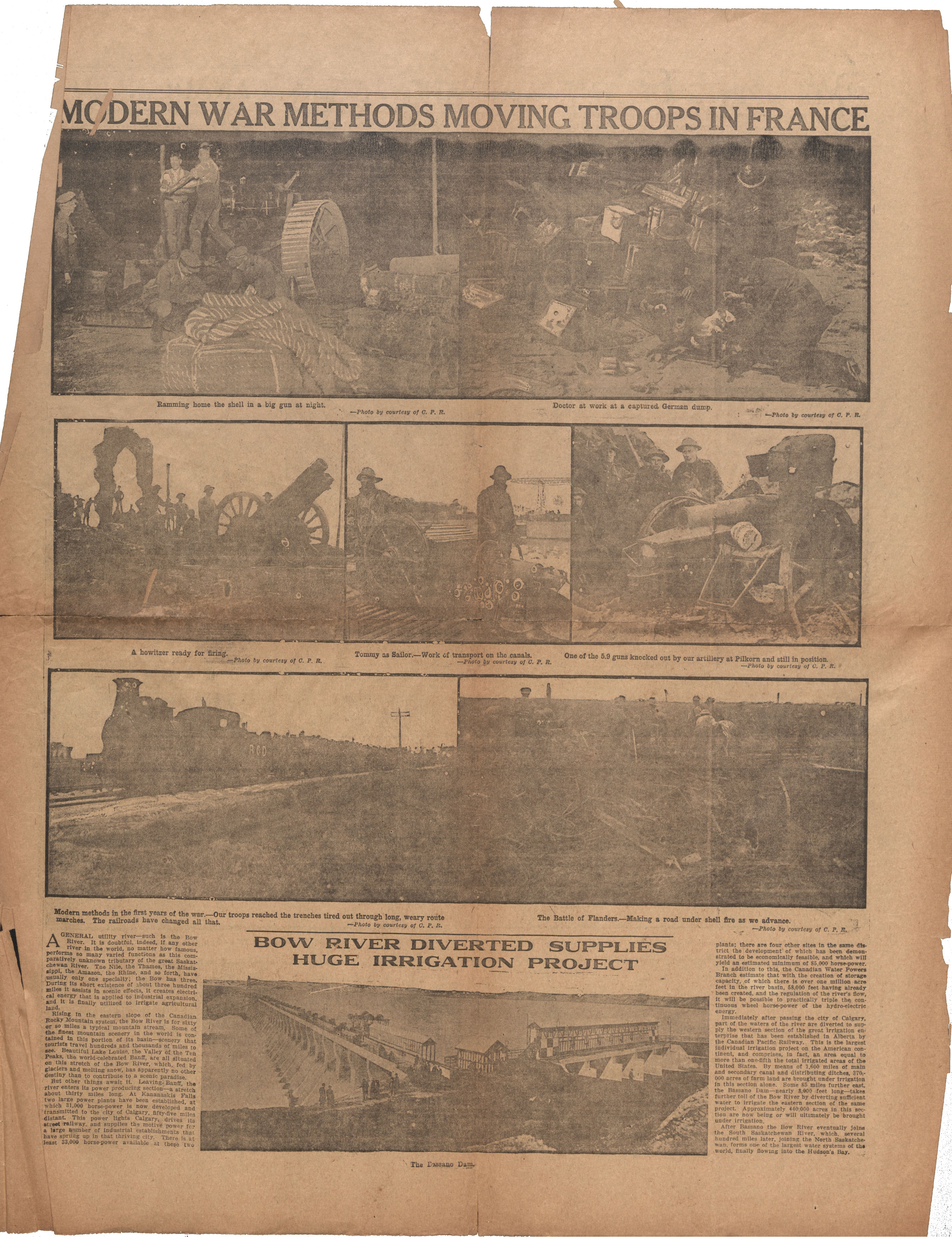Nova Scotia Archives
Archibald MacMechan
Halifax Disaster Record Office Materials
The Halifax Herald
10 December 1917. — 4 pages : 30 x 40 cm.
note: transcription publicly contributed - please contact us with comments, errors or omisions
MODERN WAR METHODS MOVING TROOPS IN FRANCE
Ramming home the shell in a big gun at night.
-Photo by courtesy of C. P. R.
Doctor at work at a captured German dump.
-Photo by courtesy of C. P. R.
A howitzer ready for firing.
-Photo by courtesy of C. P. R.
Tommy as Sailor. -Work of transport on the canals.
-Photo by courtesy of C. P. R.
One of the 5.9 guns knocked out by our artillery at Pilkorn and still in position.
-Photo by courtesy of C. P. R.
Modern methods in the first years of the war. - Our troops reached the trenches tired out through long, weary route marches. The railroads have changed all that.
-Photo by courtesy of C. P. R.
The Battle of Flanders.-Making a road under shell fire as we advance.
-Photo by courtesy of C. P. R.
BOW RIVER DIVERTED SUPPLIES HUGE IRRIGATION PROJECT
A GENERAL utility river-such is the Bow River. It is doubtful, indeed, if any other river in the world, no matter how famous performs so many varied functions as this comparatively unknown tributary of the great Saskatchewan River. Tae Nile, the Thames, the Mississippi, the Amazon, the Rhine, and so forth, have usually only one specialty; the Bow has three. During its short existence of about three hundred miles it assists in scenic effects, it creates electrical energy that is applied to industrial expansion, and it is finally utilized to irrigate agricultural land.
Rising in the eastern slope of the Canadian Rocky Mountain system, the Bow River is for sixty or so miles a typical mountain stream. Some of the finest mountain scenery in the world is contained in this portion of its basin-scenery that tourists travel hundreds and thousands of miles to see. Beautiful Lake Louise, the Valley of the Ten Peaks, the world-celebrated Banff, are all situated on this stretch of the Bow River, which, fed by glaciers and melting snow, has apparently no other destiny than to contribute to a scenic paradise.
But other things await it. Leaving Banff, the river enters its power producing section-a stretch about thirty miles long. At Kananaskis Falls two large power plants have been established, at which 31,000 horse-power is now developed and transmitted to the city of Calgary, fifty-five miles distant. This power lights Calgary, drives its street railway, and supplies the motive power for a large number of industrial establishments that have sprung up in that thriving city. There is at least 33,000 horse-power available at these two plants; there are four other sites in the same district the development of which has been demonstrated to be economically feasible, and which will yield an estimated minimum of 85,900 horse-power.
In addition to this, the Canadian Water Powers Branch estimate that with the creation of storage capacity, of which there is over one million acre feet in the river basin, 58,000 feet have already been created, and the regulation of the river's flow, it will be possible to practically triple the continuous wheel horse-power of the hydro-electric energy.
Immediately after passing the city of Calgary, part of the waters of the river are diverted to supply the western section of the great irrigation enterprise that has been established in Alberta by the Canadian Pacific Railway. This is the largest individual irrigation project on the American continent, and comprises, in fact, an area equal to more than one-fifth the total irrigated areas of the United States. By means of 1,600 miles of main and secondary canal and distributing ditches, 370,000 acres of farm land are brought under irrigation in this section alone. Some 85 miles further east, the Bassano Dam - nearly 8,900 feet long-takes further toll of the Bow River by diverting sufficient water to irrigate the eastern section of the same project. Approximately 440,000 acres in this section are now being or will ultimately be brought under irrigation.
After Bassano the Bow River eventually joins the South Saskatchewan River, which, several hundred miles later, joining the North Saskatchewan, forms one of the largest water systems of the world, finally flowing into the Hudson's Bay.
Reference: Archibald MacMechan Nova Scotia Archives MG 1 volume 2124 number 243

